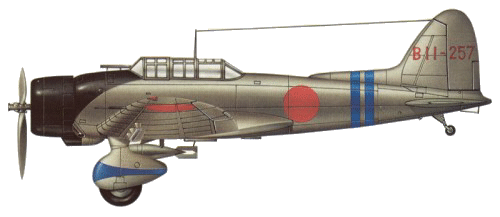Designed to supersede
the D1A, the Aichi D3A became far better known than its predecessor. Of
low-wing monoplane configuration, the prototype had elliptical wings
similar to those of the Heinkel He 70, a conventional tail unit, and a
circular-section fuselage. Construction was basically all-metal.
Non-retractable tailwheel landing gear incorporated main units with
large speed fairings, and the prototype's powerplant was the 730 hp
(544 kW) Hikari 1 radial that had powered the D1A2. Testing showed that
the aircraft was underpowered, had a tendency to snap roll in tight
turns, and had ineffective dive brakes. The second prototype
incorporated modifications to overcome these shortcomings, including
increased wing span, changed outboard wing section leading edges to
over-come the roll problem, strengthened dive brakes, and an 840 hp
(626 kW) Mitsubishi Kinsei 3 radial engine. In this form the type
proved superior to Nakajima's contender for this requirement, and in
December 1939 was ordered into production under the designation Navy
Type 99 Carrier Bomber Model 11 (Aichi D3A1).

Production aircraft
differed from the second prototype by having a small decrease in wing
span, and directional stability was improved by the addition of a long
dorsal fin. Power was again increased, with the introduction of a 1,000
hp (746 kW) Mitsubishi Kinsei 43 engine on early production models. In
this form the D3A1 completed carrier trials aboard the Kaga and
Akagi, and entered operational service with the navy in China
and Indo-China. A total of 129 of these dive-bombers was carried by the
task force that launched the attack on Pearl Harbor, and it was a force
of D3A1s that sank the British aircraft carrier HMS Hermes, and the
cruisers HMS Comwall and HMS Dorsetshire, in April 1942. At this time,
the Aichi D3A enjoyed a bombing accuracy of 80 - 82 percent, and after
releasing their bombs they were still effective dogfighters. This
changed in late 1943, when the loss of skilled pilots saw the bombing
accuracy drop below 10 percent, and this aircraft type ceased to be an
effective threat.
Identified by the
Allies under the codename 'Val', a total of 1,495 D3As of different
versions was built. These included the two prototypes, plus six service
trials and 470 D3A1 production aircraft. Then followed a single
prototype of an improved D3A2 Model 12 which, first flown in June 1942,
differed by having a modified rear canopy, a 1,300 hp (969 kW)
Mitsubishi Kinsei 54 radial engine driving a propeller with spinner,
and increased fuel capacity to cater for the more powerful engine. Duly
ordered as the D3A2 Model 22, this was the major production version, a
total of 1,016 being built by Aichi (815) and Showa (201). With a
maximum take-off weight of 8,378 lbs (3800 kg), the D3A2 had a maximum
speed of 267 mph (430 km/h) at 20,340 ft (6200 m) and service ceiling
of 34,450 ft (10500 m). Final variant was the D3A2-K bomber trainer, of
which an unspecified number of conversions were made from D3A2s late in
the war after the type had been relegated to second-line duties. With
the appearance of the Yokosuka D4Y Suisei, the Aichi D3A was relegated
to lesser important operations. Nevertheless, D3As remained in service
from beginning to end of the Pacific war, serving finally in kamikaze
roles. Nakajima developed a smaller version of this aircraft with
retractable landing gear (D3N1), but the type was never adopted.

An Aichi D3A1 "Val" of the Japanese Imperial Navy - Modern Day Replica
Variants
Aichi D3A2 Model 12 - A
single prototype of an improved version with a 1,300 hp (969 kW)
Mitsubishi Kinsei 54 engine, increased fuel capacity, a modified rear
canopy and introducing a propeller spinner.
Aichi D3A2 Model 22 - A
production version of the single Model 12 prototype. Maximum level
speed 267 mph (430 km/h) at 20,340 ft (6200 m). Service ceiling 34,450
ft (10500 m). An empty weight of 5,666 lbs (2570 kg) with a maximum
take-off weight of 8,378 lbs (3800 kg). A total of 1,016 of this type
were built.
Aichi D3A2-K - A late
war conversion of an unknown number of aircraft for use as a trainer.
(Navy Type 99 Carrier
Bomber Model 11 - Aichi D3A1)
Allied Codename:
Val
Type: Two Seat
Carrier or Land Based Dive Bomber
Design: Aichi
Tokei Denki KK Design Team
Manufacturer:
Aichi Tokei Denki KK (D3A2 - 815 aircraft) & Showa Hikoki Kogyo KK
(D3A2 - 201 aircraft)
Powerplant:
(D3A1) One 1,070 hp (798 kW) Mitsubishi Kinsei 44 14-cylinder radial
engine. (D3A2) One 1,300 hp (969 kW) Mitsubishi Kinsei 54 radial
engine.
Performance:
(D3A1) Maximum speed 242 mph (389 km/h) at 9,845 ft (3000 m); cruising
speed 183 mph (295 km/h) at 9,845 ft (3000 m); service ceiling 30,510
ft (9300 m). (D3A2) Maximum speed 267 mph (430 km/h) at 20,340 ft (6200
m); service ceiling 34,450 ft (10500 m).
Range: 913 miles
(1470 km) on internal fuel with a single 551 lbs (250 kg) bomb.
Weight: Empty
5,309 lbs (2408 kg) with a maximum take-off weight of 8,047 lbs (3650
kg).
Dimensions: Span
47 ft 1 1/2 in (14.36 m); length 33 ft 5 1/4 in (10.19 m); height 12 ft
7 1/2 in (3.85 m); wing area 375.67 sq ft
(34.90 sq m).
Armament: Two
fixed forward firing 7.7 mm (0.303 in) Type 97 machine guns, one 7.7 mm
(0.303 in) Type 92 machine gun on a trainable mount in rear cockpit
plus one 551 lbs (250 kg) centerline bomb and two 132 lbs (60 kg) of
bombs on under wing racks.
Variants: D3A1, D3A2 Model 12 (single prototype), D3A2 Model 12, D3A2-K
(trainer conversion).
Avionics: None.
History: First
flight August 1936; first flight (D3A2) June 1942; termination of
production (D3A2) January 1944.
